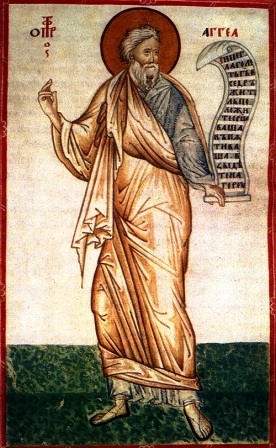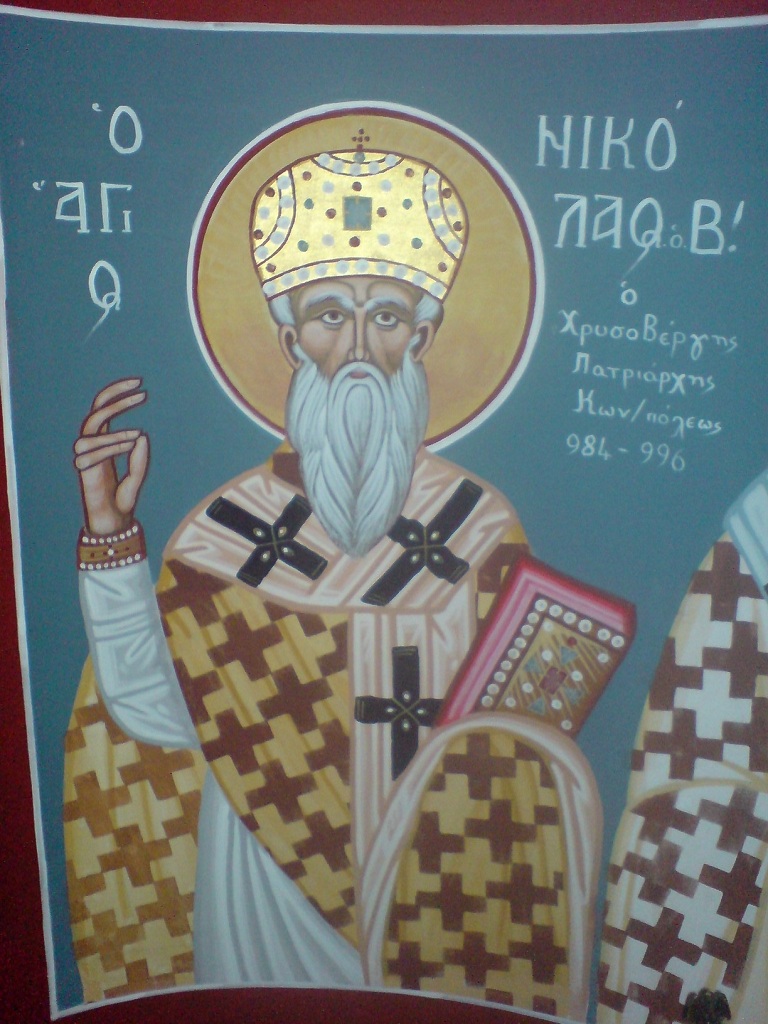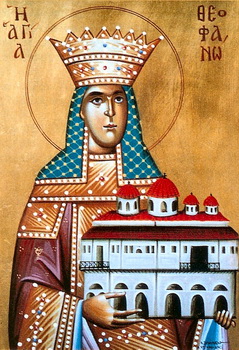|
|
The Holy Prophet Haggai Born in Babylon in the time of the captivity of Israel, he was of the tribe of Levi. He prophesied in 520 B.C., and visited Jerusalem as a young man. He urged Zerubbabel and Joshua the priest to restore the Temple of the Lord in Jerusalem, prophesying for this Temple greater glory than the former Temple of Solomon: "The glory of this latter house shall be greater than that of the former, saith the Lord of Hosts" (2:9), for the Lord, the Saviour, would appear in the new Temple. He lived to see the first half of the new Temple completed by Zerubbabel, and died in old age, and rested with his fathers. Born in Babylon in the time of the captivity of Israel, he was of the tribe of Levi. He prophesied in 520 B.C., and visited Jerusalem as a young man. He urged Zerubbabel and Joshua the priest to restore the Temple of the Lord in Jerusalem, prophesying for this Temple greater glory than the former Temple of Solomon: "The glory of this latter house shall be greater than that of the former, saith the Lord of Hosts" (2:9), for the Lord, the Saviour, would appear in the new Temple. He lived to see the first half of the new Temple completed by Zerubbabel, and died in old age, and rested with his fathers.St Nicolas Chrysoverges, Patriarch of Constantinople He governed the Church from 984 to 996, and ordained the great Symeon the New Theologian priest when this spiritual giant was chosen as the superior of the monastery of the holy martyr Mamas in Constantinople. In his days, there came to pass a wonderful revelation of the Archangel Gabriel at Karyes, when he at that time taught the monk to praise the Mother of God with the hymn "It is meet writing the hymn on tablets in a chapel of one of the cells, which has been known from that time by the name "It is meet" (see June 13th). He was a great and eminent hierarch, and entered peacefully into rest in the Kingdom of God. He governed the Church from 984 to 996, and ordained the great Symeon the New Theologian priest when this spiritual giant was chosen as the superior of the monastery of the holy martyr Mamas in Constantinople. In his days, there came to pass a wonderful revelation of the Archangel Gabriel at Karyes, when he at that time taught the monk to praise the Mother of God with the hymn "It is meet writing the hymn on tablets in a chapel of one of the cells, which has been known from that time by the name "It is meet" (see June 13th). He was a great and eminent hierarch, and entered peacefully into rest in the Kingdom of God.St Theophano the Empress She was born of eminent parents, Constantine and Anna, who were kin to several Emperors. Her parents were for a long time childless, and besought the Mother of God to give them a family. God gave them this daughter, Theophano. Imbued with a Christian spirit right from her youth, Theophano outstripped her companions in every Christian virtue. When she had grown up, she entered into marriage with Leo, the son of the Emperor Basil the Macedonian, and endured much misfortune alongside her husband. Reacting to the slander that Leo carried a knife in his breast with which, at the right opportunity, to kill his father, the Ilible Basil shut his son and daughter-in-law up in prison, and these two innocent souls spent three years there. Then, one day, on the feast of the holy prophet Elias, the Emperor summoned all his nobles to court for a feast. At one moment, the Emperor"s parrot suddenly spoke these words: "Alack, alack, my Lord Leo!", and it repeated these words a number of times. This caused great confusion among the courtiers, and they all begged the Emperor to release his son and daughter-in-law. The Emperor was touched, and did so. After his father"s death, this Leo became Emperor, being called "the Wise". Theophano did not consider her imperial dignity to be of much account, but, being utterly given to God, she gave thought to the salvation of her soul, fasting and praying and giving alms, founding monasteries and churches. No lying word ever passed her lips, nor any unnecessary speech or the least slander. At the time of her death, she called together her closest friends and took leave of them, then gave her soul to God, in 892. The Emperor Leo wanted to build a church over her grave, and, when the Patriarch refused to allow this, built the church of All Saints, saying that, if Theophano were a saint, she would be glorified together with the others. At that time, the feast of All Saints was introduced, to be celebrated on the Sunday after the feast of the Holy Trinity. She was born of eminent parents, Constantine and Anna, who were kin to several Emperors. Her parents were for a long time childless, and besought the Mother of God to give them a family. God gave them this daughter, Theophano. Imbued with a Christian spirit right from her youth, Theophano outstripped her companions in every Christian virtue. When she had grown up, she entered into marriage with Leo, the son of the Emperor Basil the Macedonian, and endured much misfortune alongside her husband. Reacting to the slander that Leo carried a knife in his breast with which, at the right opportunity, to kill his father, the Ilible Basil shut his son and daughter-in-law up in prison, and these two innocent souls spent three years there. Then, one day, on the feast of the holy prophet Elias, the Emperor summoned all his nobles to court for a feast. At one moment, the Emperor"s parrot suddenly spoke these words: "Alack, alack, my Lord Leo!", and it repeated these words a number of times. This caused great confusion among the courtiers, and they all begged the Emperor to release his son and daughter-in-law. The Emperor was touched, and did so. After his father"s death, this Leo became Emperor, being called "the Wise". Theophano did not consider her imperial dignity to be of much account, but, being utterly given to God, she gave thought to the salvation of her soul, fasting and praying and giving alms, founding monasteries and churches. No lying word ever passed her lips, nor any unnecessary speech or the least slander. At the time of her death, she called together her closest friends and took leave of them, then gave her soul to God, in 892. The Emperor Leo wanted to build a church over her grave, and, when the Patriarch refused to allow this, built the church of All Saints, saying that, if Theophano were a saint, she would be glorified together with the others. At that time, the feast of All Saints was introduced, to be celebrated on the Sunday after the feast of the Holy Trinity. |